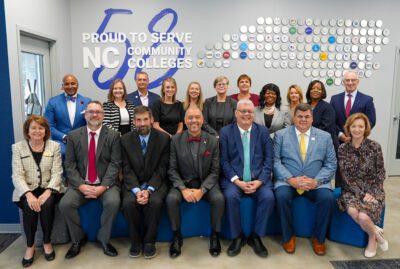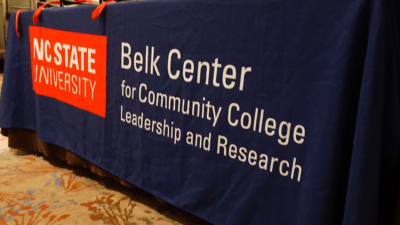
North Carolina remains a national leader in business. Yet we are 31,000 workers short of our statewide postsecondary attainment goal. Community colleges and 4-year institutions alike are ready to deliver that talent.
In this installment of our community college transfer series, we identify the groups of students that most often confront barriers throughout the transfer pipeline. We also offer some initial strategies to overturn those obstacles.
Nearly 15,000 community college students graduated last year with associate of arts or science degrees, degrees designed to transfer. We need that talent to fill the job openings popping up across the state.
But too much talent still falls through the pipeline. Just a fourth of North Carolinians successfully transfer to a 4-year institution in six years. That is far below the national average (33%). Even fewer graduate with a bachelor’s degree.
At least 5,000 community college graduates each year with those degrees can make the jump to a 4-year institution. Most of these students have long been underrepresented on these campuses.
What if more students transferred and earned bachelor’s degrees?
They would experience an average lifetime earnings boost of $400,000 — the equivalent of a down payment on a house or capital to start a business. They would be eligible for two-thirds of all high-wage, family-sustaining jobs in the next decade.
We need to identify why many talented North Carolinians miss out on these opportunities. Let’s start with the very first math and English courses that students take in community college. Students from underrepresented backgrounds complete these at a far lower rate than their peers. As a result, they’re more likely to feel like higher education is not for them — and far less likely to transfer.
Advisors can help navigate the transition to a college classroom and foster skills essential to success throughout the rest of their journey. After all, many students are the first in their families to have this experience. However, we need to invest in additional professional learning opportunities for advisors. Far more students would pass those entry-level courses. Far more would be poised to transfer.
Many students who overcome that obstacle still don’t even consider transferring. They are deterred by the rising cost of college, inconsistent credit transfer guidelines, and a belief they wouldn’t belong on a 4-year campus.
What if more institutions provided a guaranteed transfer pathway for students starting community college? Transfers pay community college tuition for the first two years of a 4-year education. They access an online platform that shows exactly which course credits will transfer in their field of interest at a given college. And after crossing the graduation stage to receive that associate degree, a 4-year campus is waiting for them.
Guaranteed admissions programs have existed in pockets, including here at NC State. But now they are becoming a regular presence in our higher education landscape. Just last month, Beaufort County Community College announced students who complete an associate degree in business administration are automatically admitted to East Carolina University. Farther west, Guilford Tech Community College manages two co-admissions programs with North Carolina A&T University and University of North Carolina-Greensboro. Guilford Tech students engage with 4-year advisors right away to minimize credit loss, participate in co-curricular programs and on-campus events, and are eligible for additional scholarship opportunities.
Four-year institutions cannot just focus on increasing transfer enrollment. Too few North Carolinians who transfer do not earn a bachelor’s degree, especially those from lower-income backgrounds and underserved communities. These disparities suggest colleges must also invest in supports and services that students need to thrive.
North Carolina educators and leaders must monitor disaggregated student transfer rates, GPA, and graduation rates to identify which have the most impact — and for whom. They should also consider qualitative indicators of the student experience.
Ask: do community college students feel a sense of belonging? Are they aware of and/or regularly using support services on campus? Do they feel supported by their advisors?
Community colleges can identify how to support those who are most likely to stop out. And 4-year institutions can provide the academic, social-emotional, or financial resources transfers need for a smooth transition.
We need more than just higher education to ensure more North Carolinians make the jump to a 4-year institution. K-12, business, and community leaders must also help invest in resources that students need. These range from more robust financial aid and support in times of crisis to mental health and culturally relevant services.
We also need their support to reinforce the importance of a bachelor’s degree. More people are skeptical of the value of college. And we will not be able to meet the demand from North Carolina employers if fewer students earn the credential.
Fortunately, the talent is here. We can draw on promising strategies from across the state to ensure their success. Let’s put them into practice and ensure talent from all corners of the state can realize the benefits of transfer.
Recommended reading



